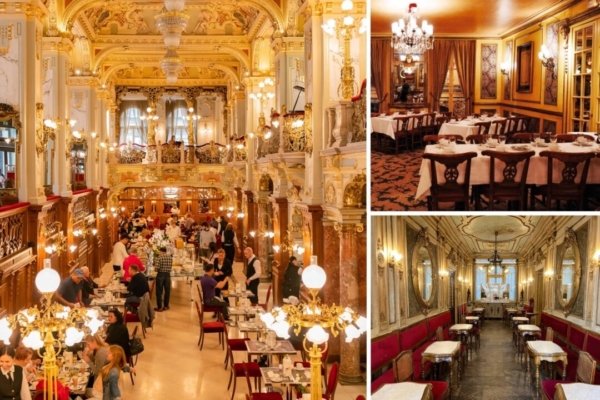Intriguing Coffee Houses Around the World
These cafés captivate with their architectural beauty and rich history. They were built in an era when drinking coffee meant pausing to savor your favorite taste and immerse yourself in a historical atmosphere.
For years, these unique cafés have attracted many eminent figures, from kings to writers and philosophers, even a founding father. They gathered to discuss, exchange ideas, and enjoy hot beverages.
Let’s take a journey to some of the most breathtaking cafés in the world, uncovering the uniqueness of each one.
This year marks the 130th anniversary of this café, renowned as one of the most beautiful in the world. The New York Café in Budapest, named after the insurance company that commissioned its construction, quickly became the hub of Budapest’s literary and artistic life since its completion in 1894.
The café boasts high ceilings adorned with murals and sparkling Venetian chandeliers, twisted marble columns, and gilded railings that attract visitors. In addition to its serene atmosphere, pianists and string quartets perform regularly, and literary events are often held to pay homage to the café’s rich history.
Located within Austria’s largest art museum, the Kunsthistorisches Museum, the Café features opulent interior décor with marble, stucco, and gold leaf decorations, as well as Renaissance-style murals. On Thursday evenings, the café transforms into a dining venue, offering select drinks, dishes, and the finest Viennese coffee.
The Confeitaria Colombo café in Rio de Janeiro draws inspiration from European cafés and has become a renowned landmark since opening in 1894. In the early 1900s, it underwent a renovation in the Art Nouveau style, which proudly remains to this day. The café features large mahogany-framed Belgian mirrors, marble-top tables, and unique skylights.
Located in Venice’s iconic Piazza San Marco, Café Florian is Italy’s oldest café, in operation for over 300 years despite major expansions and renovations in the mid-1800s. Today, it boasts six uniquely themed halls adorned by famous 18th-century Italian artists.
In the early 20th century, Café Florian introduced the concept of “café concerts,” providing guests with live orchestra performances while enjoying their coffee. This tradition continues today, featuring romantic songs, opera pieces, classical music, evergreen tunes, and even some modern melodies during warmer months.
Situated in the heart of Vienna, Café Central embodies the essence of Viennese coffee culture with a remarkable ambiance and a strong Italian influence. Housed in a luxurious building dating back to 1860, it showcases an elegant fusion of Venetian and Florentine architectural elements, inspired by the architect’s travels in Italy.
Viennese writer and poet Peter Altenberg’s paper statue greets guests at Café Central – one of the café’s most loyal patrons. Altenberg spent a considerable amount of time at the café, even having mail and clothing delivered there.
Over the years, Café Central has also attracted other notable figures, including psychoanalyst Sigmund Freud, writer Alfred Polgar, and political activist Theodor Herzl.
Paris abounds with charming cafés, each contributing to its reputation as the “City of Light.” Café de la Paix is renowned for its rich history – with royal patrons, celebrities, and cultural icons. It is ideally located opposite one of Paris’s most iconic landmarks, the Opera Garnier.
Since its opening in 1862, Café de la Paix has been the go-to place for classic coffee paired with a croissant or a famous Opera cake, earning it the title of an excellent Parisian tearoom.
Compared to the aforementioned cafés, the majestic Majestic Café in Porto, opened in 1922, is relatively young with just over a century of history. Its design reflects the “Belle Époque,” an era of beauty, located on Santa Catarina Street, once frequented by society’s elite members.
The Majestic Café adopts typical Art Nouveau style, featuring large Flemish mirrors, leather upholstery, and a delicate fusion of marble and metal.
From the start, this café has attracted local and international celebrities. In recent years, it gained prominence after being frequented by JK Rowling, who wrote part of the first Harry Potter book here when she was still an unknown author.
Founded in 1686, Le Procope is Paris’s oldest café. Legend has it that in the 17th century, it was the first place in the city to serve coffee, a beverage with an exotic allure imported from the Ottoman Empire. Following a renovation in 1989, its interior décor now reflects 18th-century aesthetics.
Le Procope has been a popular meeting place for intellectuals, proudly displaying mementos of famous patrons like Voltaire and Jean-Jacques Rousseau. It even has ties to America: Benjamin Franklin is said to have drafted the Franco-American Alliance here during the American Revolutionary War.
Established in 1858, Café Tortoni is the oldest café in Buenos Aires. Its marble tables have welcomed famous writers like Jorge Luis Borges and tango legend Carlos Gardel, who even had his own private reserved table to avoid fans’ gaze.
The café’s décor and atmosphere draw inspiration from classic Parisian cafés and have been a haven for culture and art since its inception. Its legacy is immortalized even in the tango piece “Viejo Tortoni” or “Old Tortoni.” Today, the café continues its tradition of live performances, offering tango and jazz acts in its atmospheric underground space.
“Les Deux Magots,” named after the two oriental figures displayed in the café, signifying its origins in the silk and novelty business became a café in 1884, marking the beginning of its legacy as a literary meeting place. Famous regulars such as Simone de Beauvoir, Jean-Paul Sartre, and Ernest Hemingway frequented the café.
Today, the café has expanded internationally, with branches in Tokyo, Prague, and London.

